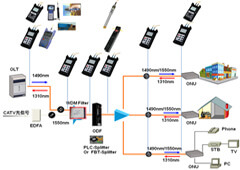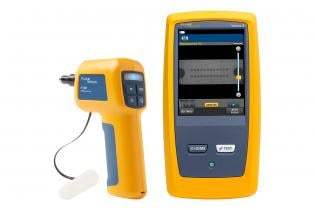Comprehending Exactly How an Optical Measurement System Enhances Precision in Industrial Applications
Optical measurement systems play an essential duty in enhancing accuracy throughout different industrial applications. By leveraging advanced modern technologies such as laser interferometry and 3D imaging sensing units, these systems use high-resolution, non-contact dimensions. This ability reduces the risk of damaging delicate components while making certain accuracy. The influence of these systems prolongs past simple measurements. Exploring their benefits, applications, and future patterns discloses a complicated landscape of innovation and difficulties that merits better evaluation.
The Essentials of Optical Measurement Systems
Optical measurement systems act as crucial tools in different commercial applications, providing precise data collection and analysis. These systems utilize light as a main means of measurement, leveraging optical concepts to evaluate measurements, positions, and surface area characteristics of items. They incorporate elements such as lasers, video cameras, and sensing units, which work together to catch high-resolution images and data.
The technology allows non-contact measurements, reducing the threat of damaging delicate parts. Optical measurement systems are versatile, locating utility in top quality control, assembly confirmation, and dimensional analysis throughout various sectors. They are especially reliable in environments where typical measurement techniques might fall short, such as gauging complex geometries or observing fast activities.
As industries remain to progress, the combination of optical measurement systems will certainly stay crucial for guaranteeing accuracy and performance, ultimately improving item quality and operational efficiency in numerous manufacturing procedures.
Secret Technologies Behind Optical Measurement
Trick technologies such as laser interferometry techniques and 3D imaging sensors play a crucial function in the efficiency of optical measurement systems (optical measurement system). These modern technologies make it possible for precise measurements and thorough analysis in various commercial applications. Comprehending their performances is vital for utilizing the full possibility of optical measurement systems
Laser Interferometry Techniques
Many laser interferometry techniques have changed the area of optical measurement, supplying unmatched accuracy and accuracy in different industrial applications. These strategies use the interference of systematic light waves to measure distance, variation, and surface area abnormalities with nanometer-level precision. Common methods include Michelson interferometry, which divides a light beam of light and analyzes phase changes, and Fabry-Pérot interferometry, understood for its high resolution in determining small changes. Additionally, laser Doppler interferometry uses frequency changes to analyze speed, making it invaluable in vibrant dimensions. The versatility of these strategies permits their assimilation into varied production processes, improving quality assurance and guaranteeing adherence to stringent resistances. Because of this, laser interferometry continues to play a vital role in progressing industrial measurement criteria.
3D Imaging Sensors
Innovations in measurement technology have actually resulted in the growth of 3D imaging sensors, which play a significant duty in optical measurement systems. These sensors record three-dimensional data through numerous methods such as triangulation, time-of-flight, and organized light. By precisely rebuilding the shape and measurements of objects, 3D imaging sensing units enhance the precision of dimensions in commercial applications. They provide real-time responses, facilitating quality assurance and guaranteeing that components meet rigid specifications. In addition, their ability to run in challenging atmospheres, such as differing lighting problems, makes them vital in making processes. As markets significantly embrace automation, the integration of 3D imaging sensors right into optical measurement systems is anticipated to drive further enhancements in effectiveness and precision.
Advantages of Optical Measurement in Sector
Typical measurement techniques have actually long been the criterion in commercial setups, optical measurement systems offer significant advantages that enhance precision and efficiency. These systems use light to catch data, leading to high-resolution dimensions that are commonly unattainable with standard strategies. The non-contact nature of optical dimensions reduces the risk of damaging sensitive components during the assessment process. Additionally, the rate of optical dimensions enables fast data purchase, promoting prompt decision-making in busy commercial settings.
Optical systems are versatile, qualified of gauging numerous products and shapes without the demand for comprehensive recalibration. This versatility adds to boosted operations and performance. The automation capacity of optical measurement systems reduces human mistake, making certain constant high quality control. Generally, the integration of optical measurement modern technology stands for a progressive change in the direction of enhanced accuracy and reliability in commercial operations, ultimately bring about enhanced item top quality and operational performance.
Applications of Optical Measurement Systems

Optical measurement systems play a critical function in boosting manufacturing process optimization by giving accurate information for decision-making. These systems guarantee quality assurance guarantee via real-time monitoring and analysis of manufacturing metrics. As industries significantly embrace these innovations, their effect on effectiveness and item dependability comes to be apparent.
Production Process Optimization
Enhancing production procedure effectiveness is significantly reliant on the integration of optical measurement systems. These systems supply real-time information on various parameters, enabling makers to analyze processes with a high level of accuracy. By making it possible for accurate dimensions of measurements, surface features, and material properties, optical measurement systems help with the recognition of inadequacies and traffic jams in assembly line. The immediate feedback from these systems empowers engineers to make enlightened choices, bring about maximized machining, assembly, and completing procedures. In addition, the ability to keep an eye on problems continually permits flexible changes, decreasing downtime and waste. As industries goal for higher efficiency and minimized functional expenses, optical measurement systems become crucial devices for boosting production procedure optimization.

High Quality Control Assurance
The combination of optical measurement systems substantially effects top quality control assurance in industrial setups. These systems provide exact and non-destructive dimensions, enabling makers to detect problems and inconsistencies early in the production process. By using innovative imaging techniques, such as laser triangulation and interferometry, optical measurement systems official site ensure that parts fulfill stringent specs. This assists in real-time monitoring, minimizing waste and lessening the danger of faulty products reaching the market. Additionally, the information gathered can be analyzed to refine manufacturing procedures better, resulting in continuous improvement. Eventually, the fostering of optical measurement systems boosts reliability and consistency in quality assurance, cultivating greater self-confidence amongst stakeholders and consumers alike in the last items supplied.
Situation Researches: Successful Applications
Countless markets have effectively incorporated optical measurement systems to boost their functional performance and item quality. As an example, in the auto market, a popular supplier took on a laser triangulation system to monitor the alignment of vehicle components. This execution greatly lowered setting up mistakes, causing boosted security and decreased expenses.
In the aerospace market, a leading aircraft supplier used optical assessment for precision dimensions of turbine blades, achieving a decrease in producing resistances and much better performance criteria.
Likewise, a consumer electronic devices company applied optical measurement modern technology during the manufacturing of mobile phone displays, leading to enhanced quality assurance and a reduction in defective products.
These study show just how optical measurement systems not only enhance precision however additionally contribute to general functional performance, demonstrating their worth throughout different sectors. By addressing details demands, these systems have verified to be essential tools in modern-day industrial applications.
Difficulties and Limitations of Optical Measurement
While optical measurement systems provide substantial advantages in different commercial applications, they are not without their challenges and restrictions. One significant issue is level of sensitivity to ecological conditions, such as temperature changes, humidity, and dirt, which can adversely affect measurement precision. In addition, optical systems typically call for precise positioning and calibration, making them susceptible to human error throughout arrangement and operation. One more restriction is the possibility for disturbance from ambient light, which can misshape measurements and require complicated filtering methods. In addition, certain products and surfaces might provide troubles, as reflective or clear features can lead to irregular analyses. The price of top quality optical parts and systems can additionally be a barrier for some industries, limiting widespread adoption. Finally, specialized training is often required for personnel to effectively operate and keep these systems, including in the total intricacy and functional difficulties.
Future Trends in Optical Measurement Technology
As advancements in modern technology continue to shape commercial processes, the future of optical measurement systems is positioned for considerable development. Arising patterns indicate a change towards enhanced assimilation of expert system and artificial intelligence, allowing systems to examine information in real-time, determine patterns, and improve decision-making procedures. In addition, the growth of miniaturized sensing units and advanced optics is anticipated to lead to more compact and versatile measurement options, making them easily accessible for his comment is here a wider series of applications.
In addition, the incorporation of 3D imaging and high-resolution abilities will certainly allow for unmatched precision in measurements, which is crucial for industries such as aerospace and vehicle. The promote automation and Industry 4.0 will likewise drive the need for optical measurement systems that can conveniently interface with other innovations. As these fads unravel, optical measurement systems will likely become essential to accomplishing greater efficiency and accuracy throughout numerous commercial sectors.

Frequently Asked Questions
Just How Do Optical Measurement Systems Contrast to Typical Measurement Techniques?
Optical measurement systems provide greater precision and speed compared to standard techniques - fibre testing equipment. They reduce human error, boost data collection performance, and supply real-time results, making them significantly liked in different industrial applications for precise dimensions
What Industries Benefit the Most From Optical Measurement Systems?
Optical measurement systems substantially benefit sectors such as aerospace, have a peek at this site automobile, and electronic devices. Their ability to give high-precision measurements boosts quality assurance, lowers production mistakes, and improves general performance, making them important in affordable manufacturing atmospheres.
Can Optical Measurement Systems Be Custom-made for Particular Applications?
Optical measurement systems can without a doubt be customized for certain applications. By adjusting specifications such as wavelength, resolution, and calibration methods, sectors can tailor these systems to satisfy one-of-a-kind precision and accuracy demands properly.
What Is the Maintenance Demand for Optical Measurement Systems?
The maintenance demands for optical measurement systems commonly include regular calibration, cleaning of optical elements, and software program updates. Complying with these methods assurances accuracy, dependability, and long life of the measurement equipment in different applications.
Exactly How Do Environmental Aspects Impact Optical Measurement Accuracy?
Ecological variables, such as temperature level changes, humidity, and dirt, substantially influence optical measurement precision. These elements can distort light paths and interfere with sensor analyses, inevitably compromising the reliability and precision of measurements in industrial setups.